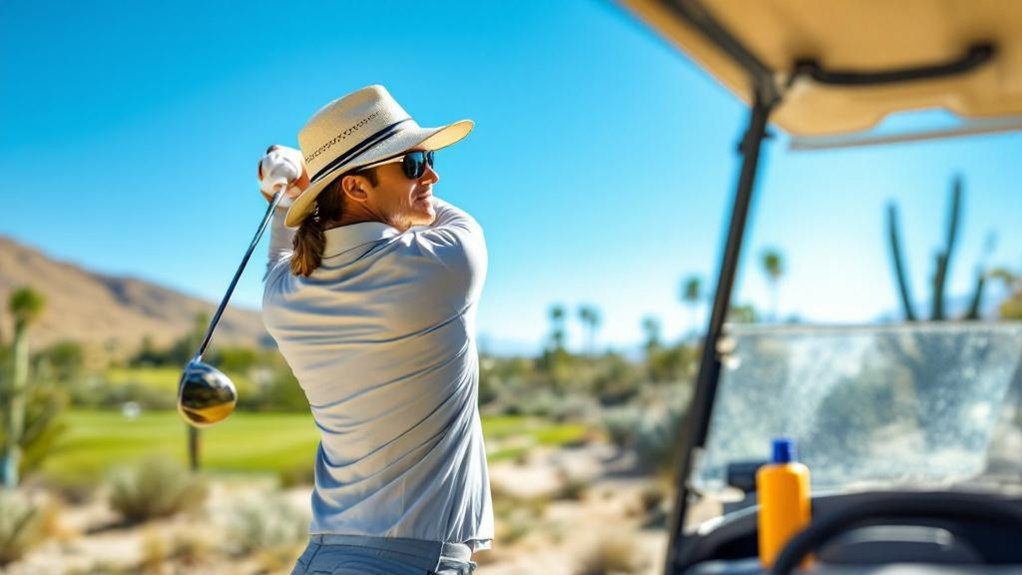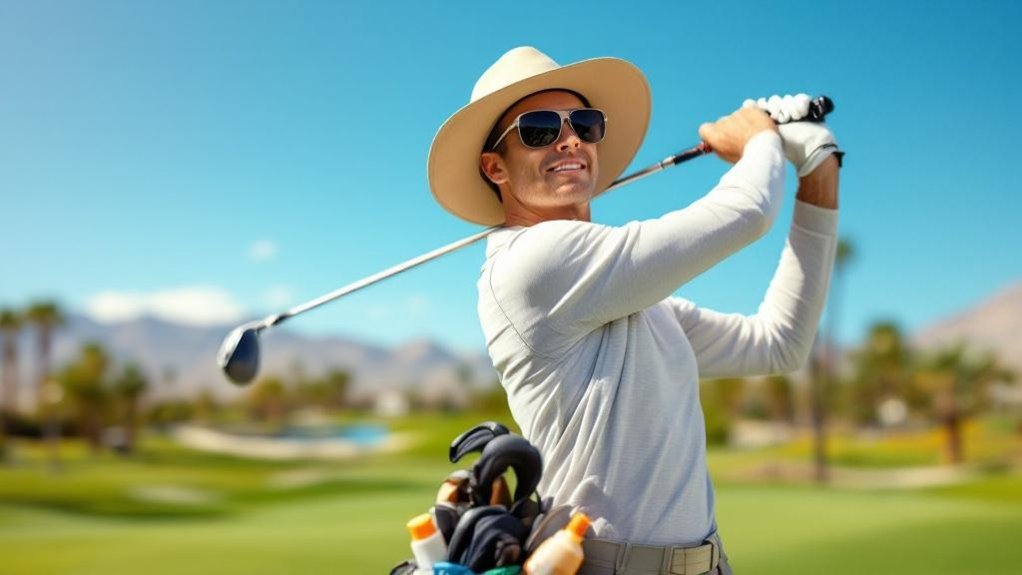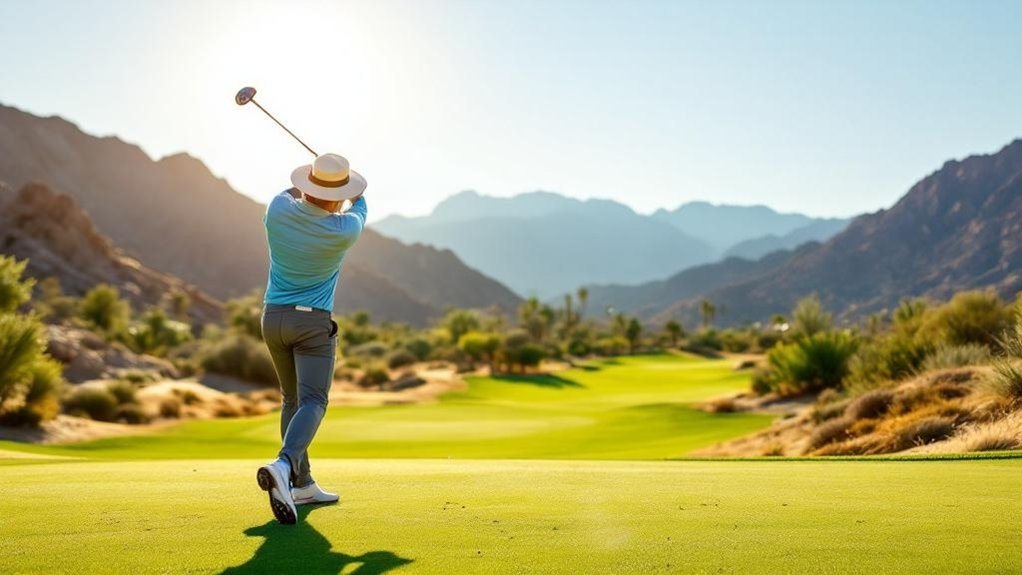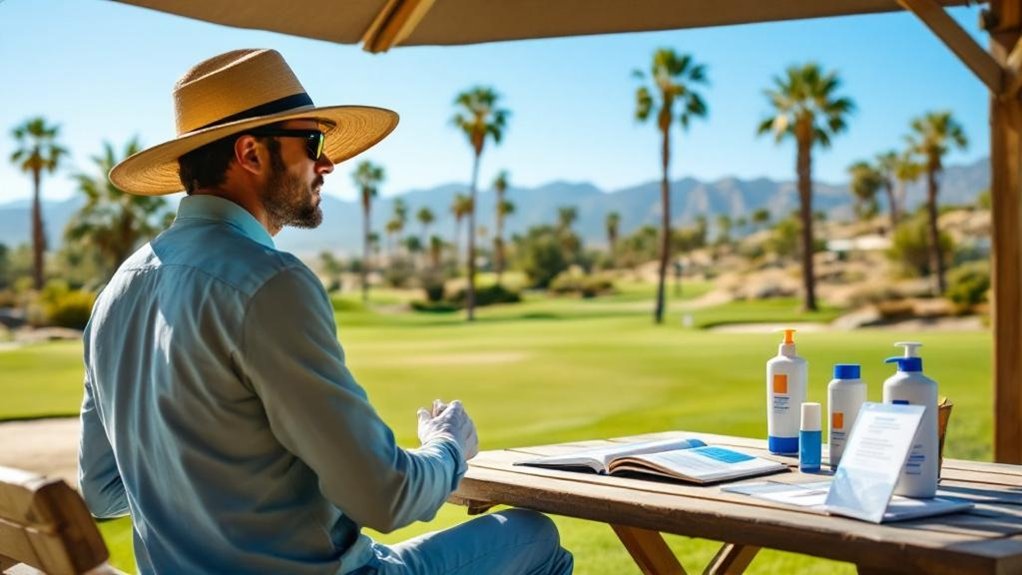Posted by: Skin And Cancer Institute in Skin Cancer

We face a 250% increased skin cancer risk as golfers compared to the general population, with Palm Springs’ desert environment intensifying UV exposure through reflection from sand and water hazards. You’ll need UPF 50+ clothing that blocks 98% of harmful radiation, broad-spectrum SPF 30+ sunscreen reapplied every 60-90 minutes, and protective accessories including wide-brimmed hats. Schedule tee times before 10 AM or after 4 PM when possible. The following extensive strategies will optimize your protection while maintaining peak performance.
Key Takeaways
- Golfers face 250% higher skin cancer risk than general population due to prolonged UV exposure during play.
- Desert conditions intensify UV radiation through sand reflection, elevation, and water hazards increasing burn risk significantly.
- Wear UPF 50+ clothing, wide-brimmed hats, and reapply SPF 30+ sunscreen every 60-90 minutes during rounds.
- Schedule tee times before 10 AM or after 4 PM to minimize exposure during peak UV hours.
- Perform monthly skin self-examinations and schedule annual dermatologist visits for early cancer detection and prevention.
Understanding Your Elevated Risk as a Palm Springs Golfer

While recreational activities often provide health benefits, golf presents a significant dermatological risk that we can’t overlook. Research demonstrates that 27% of golfers develop skin cancer compared to just 7% in the general population—a staggering 250% increased risk. Here in Palm Springs, where year-round sunshine draws golfers to pristine courses, this risk becomes particularly concerning.
The golfing demographics further amplify these statistics. With 78% of golfers being male—a key risk factor for melanoma—and many possessing fair skin, light hair, and light eyes, our local golfing community represents a high-risk population. Professional golfers develop basal cell carcinoma at an average age of 25.5 years, demonstrating how cumulative UV exposure accelerates skin cancer development decades earlier than typical patterns. Blistering sunburn significantly raises your risk of developing skin cancer later in life, making immediate sun protection crucial during those intense desert golf sessions.
Desert Environment UV Challenges and Course Conditions
Palm Springs’ desert environment creates a perfect storm of UV exposure conditions that greatly amplify the already elevated risks golfers face. Desert UV intensity peaks at 5.3 during midday hours, with elevation contributing an additional 4-6% radiation increase per 1,000-foot altitude gain. Course reflectivity compounds these hazards considerably—sand bunkers and light-colored fairways reflect 15-25% of UV radiation back toward exposed skin, while water hazards add another 10-30% through reflection. We’re particularly vulnerable because the 33% humidity creates false safety perceptions despite high UV levels. Wind speeds averaging 16 mph strip away 15-25% of applied sunscreen within thirty minutes, while the cooling effect masks sunburn development. These combined factors create cumulative exposures exceeding 1,200 UV units annually. The current low UV levels in Palm Springs demonstrate how UV intensity fluctuates throughout the day and across seasons, making it essential to check daily forecasts before heading to the course.
Essential Protective Clothing and Equipment Selection

Because standard golf attire provides inadequate UV protection—with typical cotton polo shirts offering only SPF 7.2—we must prioritize UPF 50+ rated clothing that blocks 98% of harmful radiation. Current golf apparel trends increasingly feature long-sleeve UPF 50+ polos from brands like SwingJuice and Bermies, incorporating cooling technology to prevent overheating during extended desert play.
We recommend UPF 50+ certified sun pants for thorough lower body coverage, particularly beneficial for the nearly half of golfers with sensitive skin. Essential protective accessories include UPF 50+ golf sleeves addressing uneven cart-driving exposure, wide-brimmed hats providing superior neck and ear protection compared to baseball caps, and UV-rated golf sunglasses filtering 90-95% of UVB rays. Modern UPF fabrics achieve their protective qualities through densely woven construction that creates an effective barrier against UV penetration. This thorough approach greatly reduces cumulative UV exposure during four-hour rounds.
Proper Sunscreen Application and Reapplication Strategies
We must recognize that effective sunscreen protection requires strategic timing protocols that align with golf’s extended outdoor exposure periods. Pre-round application demands a minimum 15-minute absorption window before UV exposure, while mid-game reapplication at 60-90 minute intervals maintains ideal protection levels throughout your round. Clinical evidence demonstrates that golfers who implement systematic reapplication strategies reduce their skin cancer risk by up to 40% compared to single-application approaches. Quality sunscreen should provide broad-spectrum SPF 30+ coverage to effectively shield against both UVA and UVB radiation during prolonged golf exposure.
Pre-Round Application Timing
When sunscreen application occurs too close to tee time, we’re fundamentally compromising the protective barrier our skin desperately needs during those critical first holes. Our absorption timing requires 15-30 minutes for chemical filters to bind effectively with skin proteins, creating that essential UV-protective layer. In Palm Springs’ high-altitude desert environment, we’re facing 15-25% intensified UV exposure compared to sea level conditions.
Proper application techniques demand we apply sunscreen before leaving home, not in the parking lot. Chemical sunscreens need 20+ minutes to achieve photostable protection, while physical blockers require 15 minutes for uniform distribution. Without adequate absorption timing, we’re reducing our SPF effectiveness by up to 50%, leaving ourselves vulnerable during those exposed morning hours when UV reflection from desert surfaces compounds our risk. Essential areas like the nostrils and ear tips are frequently overlooked during initial application, creating vulnerable spots that can lead to painful burns during extended rounds.
Mid-Game Reapplication Methods
Although initial sunscreen application provides our foundational protection, mid-round reapplication represents the critical difference between thorough UV defense and cumulative skin damage during extended golf exposure. We must reapply every two hours and immediately after sweating or toweling off. Strategic timing at the 9th hole shift guarantees consistent coverage throughout 18-hole rounds.
Optimal sunscreen types include solid stick formulations that won’t compromise grip integrity and sweat-resistant products validated for 80-minute protection. Our application techniques require the two-finger rule for adequate quantity, focusing on critical zones: neck, ears, hands, and scalp part lines. We’ll apply exclusively on cart paths, maintaining three feet from greens and tees to prevent turf damage. Allow fifteen minutes for absorption before resuming play.
Non-greasy formulations ensure that reapplication doesn’t create slippery hands that could affect your swing during critical shots on the back nine.
High-Risk Factors That Increase Your Vulnerability

Since golfers face a 250% greater skin cancer risk compared to non-players, understanding specific vulnerability factors becomes essential for effective prevention. We must recognize that genetic predisposition notably impacts our susceptibility—Caucasian men over 40 with pale skin, light eyes, and fair hair face heightened melanoma risk. Our behavioral habits compound these dangers through inconsistent sunscreen reapplication and inadequate protective clothing during extended play. Environmental factors intensify exposure, as we receive 3.5 to 5.4 times the UV radiation needed for sunburn per hour on course. Previous skin cancer diagnoses, numerous moles, and history of blistering sunburns considerably elevate recurrence probability. Many golfers employ sun protection strategies, but some lack essential knowledge and do not act on suspicious skin lesions. Recognizing these cumulative risk factors empowers us to implement targeted protection strategies.
Year-Round Sun Protection Protocols for Desert Golf
While desert golf courses present exceptional challenges through intensified UV radiation and reflective terrain, implementing extensive year-round protection protocols greatly reduces our skin cancer risk. Desert environments demand consistent sun safety measures regardless of seasonal temperatures or cloud coverage. We must maintain daily SPF 30+ broad-spectrum sunscreen application, utilizing one ounce coverage thirty minutes before rounds. Critical reapplication occurs every two hours during play, targeting high-exposure areas including ears, neck, and hands.
Comprehensive UV awareness requires UPF-rated clothing throughout all seasons, coupled with 99-100% UV-blocking sunglasses and SPF lip protection. We’ll deploy cooling neck gaiters during summer months while maintaining protective protocols during seemingly mild winter conditions. Desert golf’s reflective sand and minimal natural shade necessitate portable umbrellas and strategic cart positioning for peak protection. Scheduling early morning or late afternoon tee times significantly reduces exposure to peak sun intensity while often providing cost-effective green fees.
Protective Gear That Won’t Compromise Your Game

Beyond establishing thorough protection protocols, we must select equipment that maintains our athletic performance while delivering maximum UV defense. Performance fabrics with UPF 50 rating provide 98% UV radiation blockage while specialized golf apparel integrates moisture-wicking properties that prevent overheating. Wide-brimmed hats with 3-inch brims deliver complete facial coverage without compromising swing mechanics, while golf-specific sun sleeves maintain arm protection without restricting range of motion.
UV-rated sunglasses with polarized lenses reduce desert glare while blocking 90-95% of harmful rays, featuring non-slip grips for stability during play. Golf cart modifications including UV-protective covers and retractable awnings create mobile shade solutions between holes. Research demonstrates that golfers face higher UVR exposure and increased skin cancer risk compared to the general population, making comprehensive protection essential. This thorough sun safety approach guarantees we’re protected without sacrificing the precision and comfort our game demands.
Recognizing and Avoiding Common Protection Mistakes
Although we’ve equipped ourselves with proper gear, our protection efforts often fail due to systematic application errors that compromise UV defense effectiveness. Common sunscreen myths include believing insufficient quantities provide adequate coverage—we need generous application 15-30 minutes before exposure, not immediately before play. Many golfers skip vital two-hour reapplication during extended rounds, particularly problematic in Palm Springs’ intense 3.5-5.4x UV environment. We often underestimate reflected radiation from sand traps and water hazards while playing during peak 10 AM-4 PM hours. Effective hydration strategies complement but don’t replace UV protection—dehydration actually exacerbates sun damage. Cloudy conditions mislead us since 80% of UV radiation penetrates overcast skies. Professional golf organizations have responded by implementing skin cancer awareness campaigns and educational initiatives to help golfers understand these protection gaps. Consistent annual dermatological screenings remain essential for early detection despite protection efforts.
Local Resources and Skin Cancer Prevention Programs

We recognize that extensive skin cancer prevention extends beyond individual protection measures to encompass community-based screening programs and educational initiatives specifically designed for high-risk populations like golfers. Local dermatology practices and cancer centers throughout regions with elevated UV exposure frequently offer free skin cancer screenings, targeted educational workshops, and golf course safety programs that address the unique occupational hazards faced by frequent golfers. These evidence-based community resources provide essential early detection services and prevention education that complement personal protective practices in reducing melanoma and non-melanoma skin cancer incidence among recreational and professional golfers. The Shoopy Scramble charity golf tournament exemplifies how golf communities can actively contribute to melanoma awareness while supporting free skin cancer screenings that have served nearly 1,000 individuals.
Free Screening Programs
Early detection remains the most critical factor in successful skin cancer treatment, which is why we strongly recommend golfers take advantage of free screenings available throughout their communities. The American Academy of Dermatology’s screening network has conducted over 2.9 million examinations since 1985, detecting more than 293,000 suspicious lesions including 33,700 suspected melanomas. These community resources provide thorough skin cancer assessments for uninsured individuals who might otherwise lack access to dermatological care.
Programs like the Destination Healthy Skin mobile screening initiative have delivered 32,000 free examinations, identifying nearly 13,000 potential cancers. Local screening events utilize state-by-state mapping systems and email alerts to notify residents within 50-mile radiuses. These evidence-based prevention programs emphasize that early intervention notably improves treatment outcomes. The mobile screening unit features a 38-foot RV equipped with two private examination rooms and volunteer dermatologists who perform on-site evaluations.
Course Safety Initiatives
Since golf courses represent high-risk environments for prolonged UV exposure, extensive safety initiatives have emerged as essential infrastructure components for protecting players throughout their rounds. We’re seeing thorough implementations of sunscreen dispensers strategically positioned at tee boxes, driving ranges, and clubhouses, providing immediate access to broad-spectrum protection during multi-hour play sessions. Modern shade structures now integrate seamlessly into course design, featuring UV-protective canopies at high-traffic areas and natural shade through strategic tree placement along fairways. These evidence-based interventions address documented skin cancer risks inherent in outdoor recreational activities. Course partnerships with dermatology organizations guarantee standardized safety protocols, while resource distribution stations offer complimentary protective gear during peak UV exposure periods, creating thorough protection ecosystems for our golfing community. Professional organizations like the Womens Dermatologic Society provide educational outreach specifically targeting golfers who face increased skin cancer risk due to prolonged sun exposure.
Educational Awareness Events
Beyond implementing physical safety measures on courses, community-driven educational initiatives demonstrate measurable impact in reducing melanoma incidence through targeted awareness programs. We’ve witnessed the Shoopy Scramble Golf Tournament’s decade-long commitment to our Coachella Valley community, screening nearly 1,000 residents annually with 50% requiring follow-up care. Educational workshops during May’s melanoma awareness month teach us critical warning sign identification, while community seminars distribute prevention resources through golfer networks. We’re particularly supported through partnerships with Eisenhower Health’s Luci Curci Cancer Center, which provides genetic counseling and nutrition consultations. These evidence-based initiatives create sustainable prevention models, with attendees reporting increased personal screening behaviors. Research demonstrates that targeted interventions at recreational facilities prove more effective than general population approaches for high-risk groups like golfers. We’re establishing measurable outcomes that directly link community education to early detection success.
Creating Your Personal Sun Safety Action Plan

Although skin cancer remains the most common malignancy among golfers, developing a detailed sun safety action plan can reduce your UV exposure by up to 50% during recreational play. We recommend scheduling tee times before 10 AM or after 4 PM when UV radiation peaks considerably lower. Your protective gear should include UPF 50+ long-sleeve shirts, wide-brimmed hats with 7+ cm brims, and UV-blocking sunglasses. Apply SPF 50+ mineral-based sunscreen 15-30 minutes before play, targeting critical zones like ears, neck, and hands. Reapplication every two hours remains essential regardless of sweat-resistant claims. Monthly ABCDE skin self-examinations complement annual dermatologist visits. Research demonstrates that 99.4% of participants rated sun protection interventions positively, showing strong golfer acceptance of comprehensive skin cancer prevention programs. This thorough golfer education approach transforms sun safety from reactive measures into proactive prevention protocols that protect your long-term skin health.
Frequently Asked Questions
Can I Still Get Sunburned While Playing Golf on Cloudy Days?
Yes, you’ll definitely get sunburned on cloudy days. It is understood 80% of UV exposure penetrates cloud cover, maintaining dangerous radiation levels. Cloud cover doesn’t provide adequate protection during your typical golf rounds.
How Often Should I Get Professional Skin Cancer Screenings as a Golfer?
We recommend annual skin checks as your baseline golfer routine, though high-risk individuals require biannual or quarterly screenings. Evidence shows early detection through regular dermatological surveillance greatly improves treatment outcomes for our golfing community.
What Skin Cancer Warning Signs Should I Watch for After Golfing?
We recommend monitoring for asymmetrical mole changes, irregular borders, color variations, and diameter increases exceeding 6mm. Watch for bleeding skin lesions, persistent itching, or non-healing spots on sun-exposed areas.
Are There Specific Golf Courses in Palm Springs With Better Shade?
Yes, we recommend courses with superior shade options like Shadow Ridge’s extensive palm and olive tree coverage, plus Escena’s canyon course design that provides mountain-sheltered conditions reducing UV exposure during play.
Should I Avoid Certain Tee Times to Minimize UV Exposure?
We recommend early morning tee times before 9:30 AM or late afternoon after 4:00 PM to minimize UV exposure. Peak radiation occurs between 10:00 AM-4:00 PM when dermatologic damage risk increases considerably.
Conclusion
We’ve outlined evidence-based protocols to mitigate your melanoma and non-melanoma skin cancer risks while maintaining peak performance on Palm Springs’ courses. Implementing broad-spectrum SPF 30+ sunscreens, UPF-rated protective clothing, and strategic reapplication schedules greatly reduces cumulative UV exposure. Don’t compromise your dermatologic health for short-term comfort. Schedule annual full-body skin examinations with our practice, as early detection remains your most effective defense against malignant transformation in this high-risk desert environment.